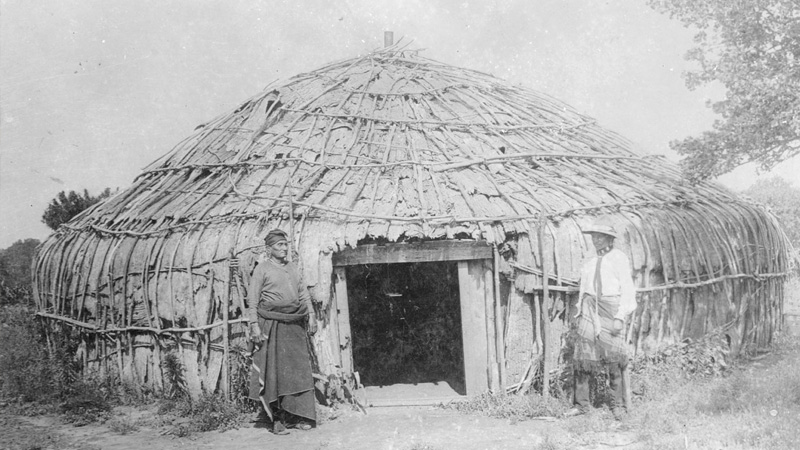Above: Kanza had ‘cabanas’, bark-covered lodges, in their villages but a skin-covered tipi was used when on the move for hunting expeditions.
In the July 2023 issue of the Mission Times (which can be viewed in the News section of the Foundation website shawneeindianmission.org), the focus was the aboriginal people for whom Kansas is named, ‘the wind people’ or Kanza. The Mission is located on the land where they once lived. Many of us today live on Mission land, which was originally 2,200 acres, stretching from State Line to Nall and 47th to 63rd. We share a feeling of homeland with the Kanza and wonder, Why did the Kanza leave their homeland?
People have migrated since humans left their African homeland 80,000 years ago and began colonizing the world. There are many reasons for migration – climate issues that impact food and water sources and security, population pressure, new opportunity, fleeing conflict and persecution, seeking freedom, and forced migration to name a few. Prior to the arrival of white people in the late 15th century, North American tribes that shared language and culture, lived together as one people in the lower Ohio Valley. These were the Dhegiha-Siouan division of the Hopewell cultures, Kaw, Osage, Ponca, Omaha, and Quapaw. As the white people arrived, the tribes migrated. The Kaw migrated along the Missouri River and settled farther west all along the Kansas or Kaw River, which bears their name. They lived in this area for centuries, where the Kanza, Osage, and Pawnee were among the dominant tribes in the region.
In 1702 it was estimated that 1,500 Kanza families were living along the Kansa River. Later, in 1723 and 1724 the Kanza were documented in similar numbers along the Big Blue River (near present-day Manhattan) as well as along Independence Creek (NW of Atchinson). There were several incursions between the Kaw and the French in the 1700’s. In the mid-1700’s fur-traders moving along the rivers carried the smallpox virus to the region and transmitted the deadly disease to the Kaw. ‘By 1765 it is estimated that one of every two Kanza males had died.’ (Kaw Nation website).
Spain gained control of Louisiana from the French, which included Kanza lands. The British and French were still both trading in this Spanish territory and wanted to control trade. In an effort to force the Spanish out of the area and to break the Kanza-French fur-trading connection, the British paid the Iowa tribe double for all the pelts that they could take from the Kaw. They also gave 150 rifles and six kegs of Brandy to the Omaha, through the Sioux, to encourage the Omaha to further disrupt Kanza trade and divide their loyalties.
In the early 1800’s the Kanza were at war with the Pawnee and the Osage. In September 1808 they made their first trip to Fort Osage on the Missouri River to trade furs with Pierre Chouteau. Because of the war, this was a dangerous journey of more than 100 miles. Records at Fort Osage note that over a thousand Kanza were camped along the Missouri River. The War of 1812 also impacted the Kaw because trade caused settlers to move west onto the Kanza lands.
The Kaw did have some friendly encounters with white people who were arriving in their homeland. According to the Kaw Nation website: ‘In August (1829) Dr. Thomas Say, an eminent naturalist, was sent out to explore the country up the Kansas River. The small band of soldiers that were his escorts were led by Major Stephen Long. They left Fort Osage on August 6, and came in contact with the Kanza people on August 20th. They were welcomed by the Kanza and were given food and lodging. Shortly after they left the Kanza village they were attacked by the Pawnee. With the help of the Kanza, they made it back to the river and then back to Fort Osage.’
In 1824 US Federal government established the Bureau of Indian Affairs within the War Department, 46 years after the first treaty was made between the US and an American Indian Tribe, the Delaware. In 1825 the Kanza ceded their 20,000,000 acres of land, including land in Missouri and all along the Kansas River. This reduced their Kansas holdings to a 30-mile wide tract of 2,000,000 acres west of Topeka. Daniel Boone, son of the prominent frontiersman, was the appointed Agent for the Kanza Indians. His Agency was near Lecompton. A son born to Boone was the first white boy born on Kanza land. In 1829 the census of the Kanza people was only 1,200. The pressures on the Kaw were mounting. Pappan’s Ferry, which became Topeka, Kansas was built in 1842. While their population had somewhat rebounded to 1,588 in 1843, a treaty in 1846 reduced the Kaw lands further when they ceded their 2 million acres near Topeka in exchange for 256,000 acres near Council Grove. In 21 years, the Kaw’s homeland had been reduced to 256,000 acres or just over one percent of their original 20,000,000 acreage.
Stay tuned for more about migrations in this Place We Call Home in the March 2025 issue of the Mission Times.

